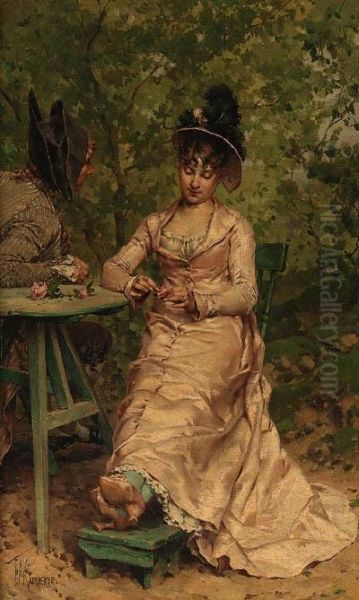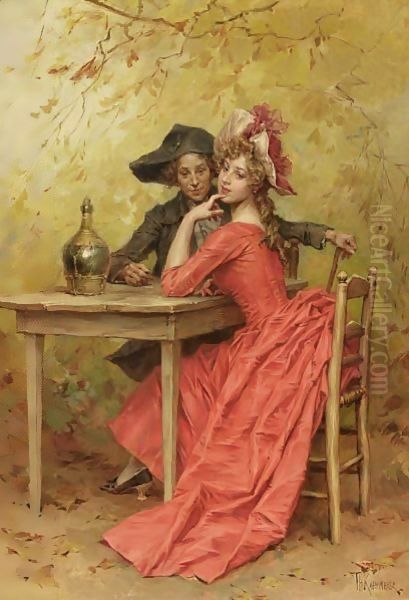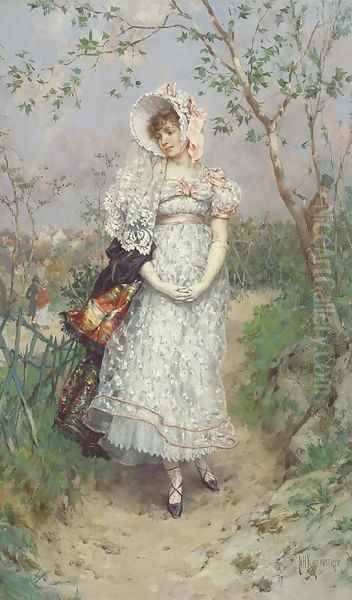Introduction: A Dutch Painter in Paris
Frederik Hendrik Kaemmerer stands as a fascinating figure in late 19th-century European art. Born in The Hague, Netherlands, on October 23, 1839, and passing away in Paris on April 4, 1902, Kaemmerer was a Dutch painter who achieved significant recognition, particularly in France. His artistic journey is notable for its transition from the traditional Dutch Romanticism and the Hague School aesthetics of his early training to the polished Academic genre scenes and, later, the lighter, brighter touches influenced by French Impressionism. He became renowned for his elegant depictions of 18th-century French society and his skillful rendering of light and texture, carving a successful career primarily centered in the bustling art world of Paris.
Early Life and Artistic Formation in The Hague
Kaemmerer's initial artistic education took place in his hometown at the prestigious Royal Academy of Art in The Hague. During this formative period, he studied under Salomon Leonardus Verveer, a respected painter associated with the Dutch Romantic tradition. Verveer specialized in landscapes and, notably, lively depictions of Dutch town scenes and Jewish neighborhoods, often imbued with a picturesque and anecdotal quality. This early training grounded Kaemmerer in the technical skills of drawing and painting prevalent in the mid-19th century Dutch art scene.
The artistic environment of The Hague at this time was increasingly dominated by the emerging Hague School. While Kaemmerer's early work, particularly his landscapes, showed an affinity with this movement's tonal palette and focus on Dutch scenery, he did not remain solely within its sphere. The Hague School, with leading figures like Jozef Israëls, the Maris brothers (Jacob, Matthijs, and Willem), Anton Mauve, and Hendrik Willem Mesdag, emphasized atmospheric landscapes and scenes of rural life, often rendered in subdued, silvery tones. Kaemmerer absorbed these influences, developing a sensitivity to atmosphere and light that would remain, albeit transformed, throughout his career.
The Parisian Transformation: New Influences and Directions

A pivotal moment in Kaemmerer's career occurred around 1865 when he decided to move to Paris, the undisputed center of the European art world. This move marked a significant shift in his artistic trajectory. In Paris, he sought further refinement and exposure to contemporary trends, enrolling in the studio of the highly influential academic painter Jean-Léon Gérôme at the École des Beaux-Arts. Gérôme was a master of Academic Classicism, renowned for his meticulously detailed historical paintings, Orientalist scenes, and mythological subjects, all executed with a polished, almost photographic finish.
Studying under Gérôme provided Kaemmerer with rigorous training in figure drawing and composition, pushing his style towards greater precision and clarity. This academic influence steered him away from the looser, more atmospheric approach of the Hague School towards a more refined, detailed execution. It was during this period that Kaemmerer began to specialize in the genre scenes, particularly those evoking the elegance and charm of 18th-century France, which would bring him considerable fame.
His integration into the Parisian art scene was further solidified by his association with the prominent art dealership Goupil & Cie. Reportedly encouraged by Gérôme, Kaemmerer began working with or for the gallery, which was a major force in the international art market, dealing in both original paintings and high-quality reproductions. Goupil & Cie played a crucial role in promoting artists and disseminating artistic trends across Europe and America. Notably, Theo van Gogh, brother of Vincent van Gogh, would later work for this gallery. This connection provided Kaemmerer with valuable exposure and commercial opportunities, allowing him to connect with collectors and fellow artists, including fellow Dutchmen also seeking success in Paris, such as Anton Mauve and Jacob Maris, who were also linked to Goupil at various times.
Artistic Style and Evolution: From Academicism to Impressionist Touches
Kaemmerer's mature style is often characterized by its blend of academic precision and a lighter, more decorative sensibility. His most popular works focused on historical genre scenes, specifically depicting fashionable life during the French Directoire and later 18th-century periods. These paintings often feature elegant ladies and gentlemen dressed in exquisite period costumes, engaged in leisurely activities such as garden parties, strolls in parks, intimate conversations, or attending social events like weddings and christenings.

His technique in these works reflects Gérôme's influence in the careful drawing, smooth finish, and attention to detail, particularly in rendering fabrics like silk, satin, and lace, as well as architectural and decorative elements. However, Kaemmerer's subject matter was generally lighter and more charming than Gérôme's often dramatic historical or exotic scenes. His paintings catered to the tastes of the Belle Époque, a period that harbored a nostalgic fascination with the perceived grace and elegance of the Ancien Régime. This style, sometimes referred to as "French genre pieux" or similar terms emphasizing its charming, anecdotal quality, found favor with critics and the public in both France and the Netherlands. Artists like the Belgian Alfred Stevens and the Italian-born Giovanni Boldini, also working in Paris, explored similar themes of elegant modern or historical society, though often with different stylistic emphases. James Tissot, another contemporary, also specialized in depicting fashionable life, though often with a more Victorian English or contemporary Parisian focus.
While deeply rooted in academic training, Kaemmerer was not immune to the revolutionary changes occurring in the Parisian art world, particularly the rise of Impressionism. Living and working in Paris during the 1870s and 1880s, he inevitably encountered the work of Impressionist painters like Claude Monet, Pierre-Auguste Renoir, Edgar Degas, and Camille Pissarro. While Kaemmerer never fully adopted the Impressionist ethos or its radical techniques, his later work, especially his outdoor scenes and seascapes, shows a distinct absorption of certain Impressionist concerns.
This influence is most evident in his treatment of light and color. His palette became brighter, and his brushwork, while often retaining a degree of finish, could become looser and more suggestive, particularly in backgrounds or depictions of foliage and water. He demonstrated a keen interest in capturing fleeting effects of sunlight, reflections on water, and the vibrant atmosphere of outdoor settings. His beach scenes, often depicting the fashionable Dutch resort of Scheveningen, are particularly noted for their bright light and lively atmosphere, moving away from the tonalism of the Hague School towards a more luminous, color-filled representation, echoing the Impressionists' plein-air practices.
Key Themes and Subjects in Kaemmerer's Oeuvre
Throughout his career, several key themes and subjects recurred in Kaemmerer's work, reflecting his stylistic evolution and market appeal.
Elegant Historical Genre: This is perhaps his most recognizable theme. Paintings depicting scenes from the late 18th century or the Directoire period (1795-1799) form a significant part of his output. These works are characterized by their focus on fashion, social rituals, and romantic encounters among the upper classes. Titles often reflect these subjects, such as A Wedding Reception under the Directory or scenes of courtship and conversation in refined interiors or manicured gardens. The appeal lay in their combination of historical detail, narrative charm, and decorative elegance.

Modern Life and Leisure: Alongside his historical scenes, Kaemmerer also painted contemporary subjects, particularly scenes of leisure. Beach scenes were a favorite topic, allowing him to explore the effects of bright sunlight, sea, and sand, and to depict fashionable society at play. Parks, boating excursions, and other outdoor recreational activities also feature in his work, aligning him with the Impressionist interest in capturing modern life, albeit generally rendered with more traditional technique than painters like Monet or Renoir.
Dutch Landscapes and Scenes: Although his focus shifted significantly after moving to Paris, Kaemmerer occasionally returned to Dutch themes or landscapes. These works might reflect his Hague School roots but often incorporate the brighter palette and light effects developed during his time in France. They serve as a reminder of his origins and his grounding in the Dutch landscape tradition, even as he achieved fame through his French-inspired subjects.
Notable Works and Recognition
While a definitive list is complex due to variations in titles and the sheer volume of genre work produced, several works and types of work are representative of Kaemmerer's career and achievements.
Masked Ball (Baile de Máscaras): Descriptions match a type of elegant social scene Kaemmerer excelled at. Though sometimes misdated to his birth year (1839), such works belong to his mature period, likely the 1870s or 1880s. These paintings typically showcase his skill in depicting elaborate costumes, varied human interactions within a festive setting, and a controlled yet lively composition, blending academic structure with anecdotal charm.
Illustrations for Neerland's Pen en Stift: Kaemmerer contributed illustrations to this publication by Elsevier, including drawings for the story Eene Illuzie by the renowned Dutch writer Louis Couperus. This demonstrates his versatility and his engagement with the publishing world, extending his reach beyond easel painting. His illustrative work likely maintained the clarity and narrative quality found in his paintings.
Works Exhibited at Salons and Expositions: Kaemmerer achieved significant official recognition. He was awarded a medal at the prestigious Paris Salon in 1874, a crucial mark of success in the competitive Parisian art world. His reputation was further cemented when he received a silver medal at the Exposition Universelle (World's Fair) held in Paris in 1889. The works praised on this occasion were noted for their skillful rendering of "transient effects of sunshine and water," highlighting the Impressionist-influenced aspects of his later style, particularly his handling of light. Specific titles that often appear associated with his name include A Christening, Beach Scene at Scheveningen, and various scenes titled Elegant Figures Strolling or similar descriptions capturing his popular genre.
His success was also commercial. The relationship with Goupil & Cie, and potentially its successor Boussod, Valadon & Cie, ensured his works reached an international clientele, particularly in the United States, where collectors favored his polished and pleasing style. He maintained friendships within the art community, including a long-standing connection with the French painter and etcher Émile Pinchart.
Kaemmerer and His Contemporaries: A Bridge Between Worlds
Frederik Hendrik Kaemmerer occupied an interesting position relative to his contemporaries. He began his career grounded in the Dutch tradition, influenced by Romanticism through Salomon Verveer and the tonal realism of the Hague School (Israëls, Mauve, the Maris brothers, Mesdag, Johannes Weissenbruch). His move to Paris, however, placed him firmly within the orbit of French Academicism under Jean-Léon Gérôme, a dominant force challenged only by the emerging avant-garde.
He successfully adapted the precision of his academic training to the lighter, more commercially viable genre of historical costume pieces, finding a niche similar to that of artists like James Tissot and Alfred Stevens, who also depicted elegant society, though Kaemmerer often favored a historical setting. Unlike the core Impressionists (Monet, Renoir, Pissarro, Degas), Kaemmerer did not fully embrace their revolutionary techniques or their focus on capturing the fleeting moment with radically broken brushwork and color theory. Instead, he selectively incorporated elements of their approach – a brighter palette, attention to light effects, modern leisure subjects – into his fundamentally more traditional framework. He represents a successful example of an artist navigating between established academic expectations and the allure of modern artistic innovations.
Legacy and Collections
Frederik Hendrik Kaemmerer enjoyed considerable popularity during his lifetime, appreciated for his technical skill, charming subject matter, and elegant execution. While perhaps not considered a major innovator in the grand narrative of art history dominated by the Impressionists and Post-Impressionists, his work remains appealing for its depiction of Belle Époque elegance and its skillful synthesis of different artistic currents.
His paintings were acquired by collectors across Europe and America and are held in various public collections. While claims of holdings in the Louvre might be inaccurate for an artist of his specific genre (such works are more typically found in museums like the Musée d'Orsay or regional French museums), his paintings are certainly represented in major Dutch museums, including the Rijksmuseum in Amsterdam and the Kunstmuseum Den Haag, as well as other European and American institutions. His work continues to appear at auction, attesting to an enduring appreciation for his refined aesthetic.
Conclusion: An Accomplished Synthesis
Frederik Hendrik Kaemmerer's career exemplifies the path of a talented artist adapting to the shifting tastes and artistic currents of the late 19th century. A Dutchman by birth and early training, he found his greatest success in Paris, mastering the polished techniques of the French academic tradition under Gérôme while specializing in charming historical genre scenes that captured the public imagination. Yet, he remained receptive to the new language of Impressionism, skillfully incorporating its lessons on light and color into his work, particularly in his depictions of modern leisure and coastal scenes. Kaemmerer remains significant as an accomplished painter who successfully bridged the worlds of Dutch tradition, Parisian academicism, and the burgeoning influence of modern art, leaving behind a body of work celebrated for its elegance, technical finesse, and sensitivity to light.